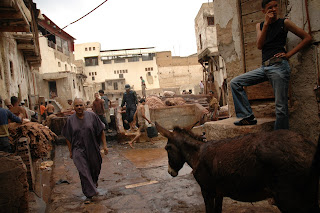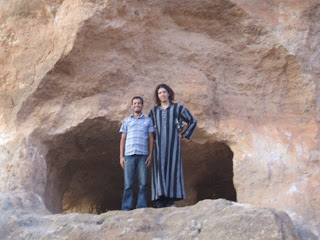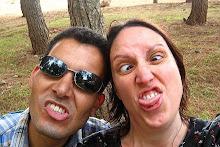




The cuisine of Morocco is rated among the best in the world, and rightly so. There are few places where food is more carefully and artistically prepared, more delightfully served, and more enjoyed than in this country.
Cooking in Morocco falls into two specific categories. The first, intended for important guests, is the work of skilled chefs. It requires such intensive supervision that the host does not participate. He merely oversees the banquet with his sons and servants. No women are present. The men squat on mattresses or pillows around low, beautifully inlaid tables. A silver ewer of perfumed water is taken around and poured over three fingers of the right hand of each guest.
The host claps his hands and the meal begins. One course after another- each delicacy is served until Chban- complete satiation- is achieved. Again the silver ewer filled with warm water is presented to clean the mouth, lips, and hands. The meal is a feast for the gods and indeed it begins and ends with Bsmillah--God's blessing.
In the second category of cookery are the wonderful dishes prepared with loving care by the mistresses- Dadas- of the homes. Here, where time does not seem to count, she spends hours with her glazed earthenware and copper cooking dishes and her kanoun, the movable clay brazier. Her kitchen is austere, and the charcoal which perfumes the kebabs and allows the sauces to simmer is the only source of heat. There are no chairs. A folded carpet serves as a seat. The Dada is dressed in a long colorful robe tucked up in front and her wide sleeves are held in place with a twisted cord.
The scents of coriander, cumin, saffron, marjoram, and onion mingle with the pungency of olive oil and the sweetness of sandalwood, mint, and roses, delighting the senses।
Cooking in Morocco falls into two specific categories. The first, intended for important guests, is the work of skilled chefs. It requires such intensive supervision that the host does not participate. He merely oversees the banquet with his sons and servants. No women are present. The men squat on mattresses or pillows around low, beautifully inlaid tables. A silver ewer of perfumed water is taken around and poured over three fingers of the right hand of each guest.
The host claps his hands and the meal begins. One course after another- each delicacy is served until Chban- complete satiation- is achieved. Again the silver ewer filled with warm water is presented to clean the mouth, lips, and hands. The meal is a feast for the gods and indeed it begins and ends with Bsmillah--God's blessing.
In the second category of cookery are the wonderful dishes prepared with loving care by the mistresses- Dadas- of the homes. Here, where time does not seem to count, she spends hours with her glazed earthenware and copper cooking dishes and her kanoun, the movable clay brazier. Her kitchen is austere, and the charcoal which perfumes the kebabs and allows the sauces to simmer is the only source of heat. There are no chairs. A folded carpet serves as a seat. The Dada is dressed in a long colorful robe tucked up in front and her wide sleeves are held in place with a twisted cord.
The scents of coriander, cumin, saffron, marjoram, and onion mingle with the pungency of olive oil and the sweetness of sandalwood, mint, and roses, delighting the senses।
A hostess in Morocco might take a week to prepare a suitable dinner for her honored guests. The meal often consists of as many as fifty courses. It would take a full day just to make Bstilla- a crisp pastry, rolled as thin as tissue paper, filled with chicken in a mixture "sweet and peppery, soft and violent."
The dinner starts with Bstilla, followed by the typical brochette or kebab flavored with bits of beef or lamb fat. Next comes the Tajine, chicken or meat in a spicy stew which has been simmered for many hours, and it is served with a flat bread called Khubz.
In Morocco, as in most Arab lands, every household makes its own bread। It is made from semolina flour without shortening or milk. An invocation to God is made before commencing the sacred act of kneading. When the bread has been properly shaped, each family puts its own mark or stamp on it before sending it via the children to a common bakery oven. After the Tajine, a Batinjaan- eggplant salad or chopped tomato salad- is served as a separate course. Then comes Couscous, that marvelous Moroccan national dish made of semolina, cooked to perfection, each grain separate from the other. The dinner is completed with slices or wedges of peeled melon, pastries made with honey and almond like the Middle Eastern Baklava, and finally a small glass of mint tea. The dinner following is a very much simplified version, but it is delicious and will give you the "feel" of Morocco. Once you have made the Couscous, it may very well become one of your favorite dishes. This is a delightful dinner to prepare and serve.
The dinner starts with Bstilla, followed by the typical brochette or kebab flavored with bits of beef or lamb fat. Next comes the Tajine, chicken or meat in a spicy stew which has been simmered for many hours, and it is served with a flat bread called Khubz.
In Morocco, as in most Arab lands, every household makes its own bread। It is made from semolina flour without shortening or milk. An invocation to God is made before commencing the sacred act of kneading. When the bread has been properly shaped, each family puts its own mark or stamp on it before sending it via the children to a common bakery oven. After the Tajine, a Batinjaan- eggplant salad or chopped tomato salad- is served as a separate course. Then comes Couscous, that marvelous Moroccan national dish made of semolina, cooked to perfection, each grain separate from the other. The dinner is completed with slices or wedges of peeled melon, pastries made with honey and almond like the Middle Eastern Baklava, and finally a small glass of mint tea. The dinner following is a very much simplified version, but it is delicious and will give you the "feel" of Morocco. Once you have made the Couscous, it may very well become one of your favorite dishes. This is a delightful dinner to prepare and serve.
How You Can Present a Moroccan Dinner
If feasible, use a low table with cushions on the floor. (Be sure to advise your guests to dress comfortably.) Cover the low table with a bright brocaded cloth and provide your guests with thick towels to cover their knees. You might want to place floral bouquets around the room, but do not have a centerpiece on the table.
Before serving the dinner, walk around the table with an attractive pitcher (silver if possible) filled with warm water which has been scented with cologne or a few drops of perfume. Carry a Turkish towel over your left arm and a small basin in your left hand. Pour a little water over the fingers of each guest, catching the water in the small basin.
Serve tiny kebabs first (with or without a fork) on small plates. As soon as the kebabs have been eaten, remove the plates. The salad may be served as a separate course or may accompany the Couscous. If you serve it separately place the salad (with a fork) in front of each guest. In Morocco, the Couscous is served in a large platter and each guest eats directly from it with a large spoon or he may roll the Couscous up in little balls and pop them into his mouth, but don't expect your guests to do this. You may prefer to place extra plates in front of your guests and ask them to serve themselves.
Slices of melon, watermelon, or cantaloupe speared with toothpicks (no plates) are served in a platter right after the Couscous. You might also serve the mint tea at this time, or wait until later to serve it with the honey pastries.
Again the hostess pours water over the fingers of her guests. This is a mark of graciousness and hospitality. At the end of the meal, after tea has been served, bring in a tiny incense burner and light it on the table.
If feasible, use a low table with cushions on the floor. (Be sure to advise your guests to dress comfortably.) Cover the low table with a bright brocaded cloth and provide your guests with thick towels to cover their knees. You might want to place floral bouquets around the room, but do not have a centerpiece on the table.
Before serving the dinner, walk around the table with an attractive pitcher (silver if possible) filled with warm water which has been scented with cologne or a few drops of perfume. Carry a Turkish towel over your left arm and a small basin in your left hand. Pour a little water over the fingers of each guest, catching the water in the small basin.
Serve tiny kebabs first (with or without a fork) on small plates. As soon as the kebabs have been eaten, remove the plates. The salad may be served as a separate course or may accompany the Couscous. If you serve it separately place the salad (with a fork) in front of each guest. In Morocco, the Couscous is served in a large platter and each guest eats directly from it with a large spoon or he may roll the Couscous up in little balls and pop them into his mouth, but don't expect your guests to do this. You may prefer to place extra plates in front of your guests and ask them to serve themselves.
Slices of melon, watermelon, or cantaloupe speared with toothpicks (no plates) are served in a platter right after the Couscous. You might also serve the mint tea at this time, or wait until later to serve it with the honey pastries.
Again the hostess pours water over the fingers of her guests. This is a mark of graciousness and hospitality. At the end of the meal, after tea has been served, bring in a tiny incense burner and light it on the table.


























